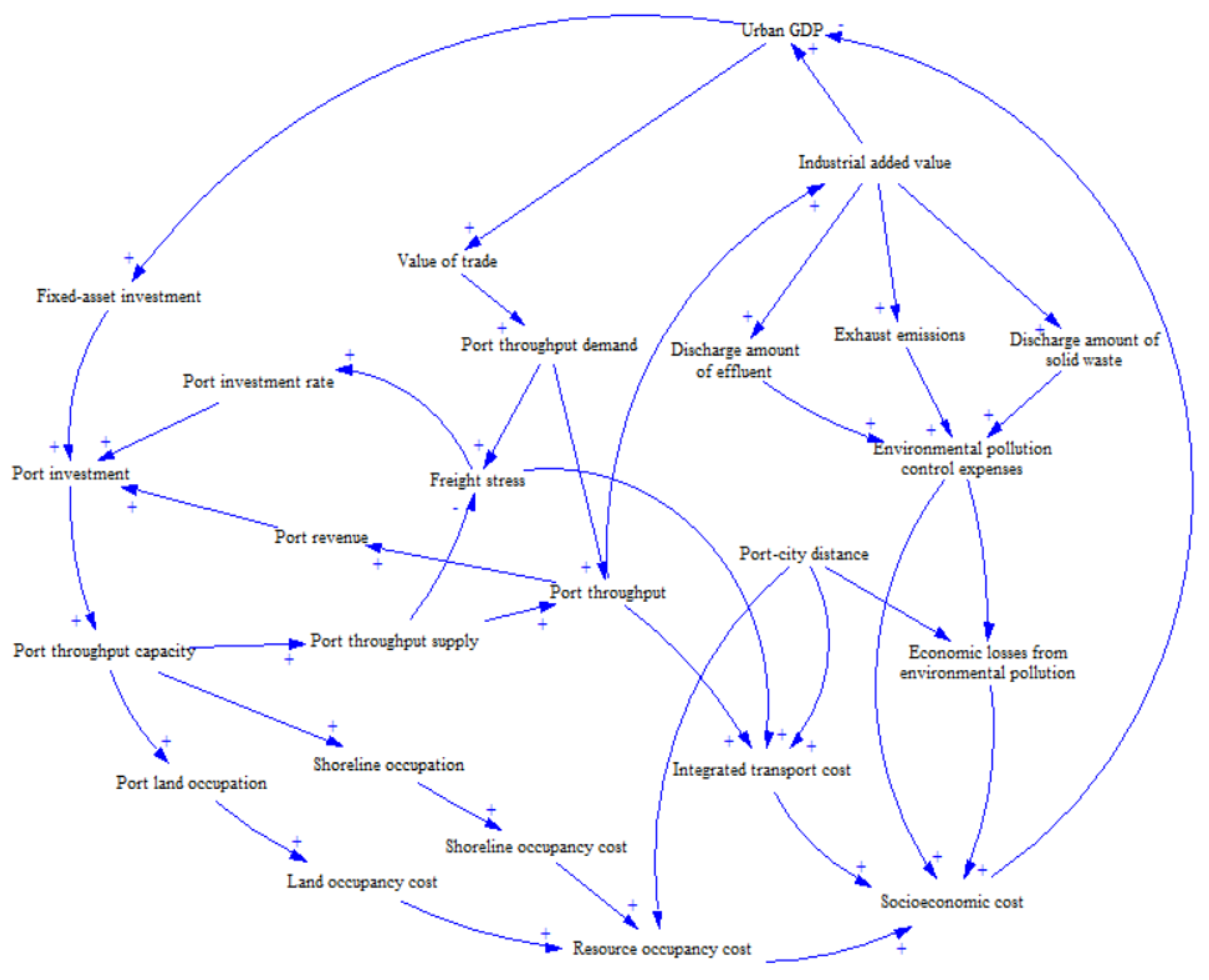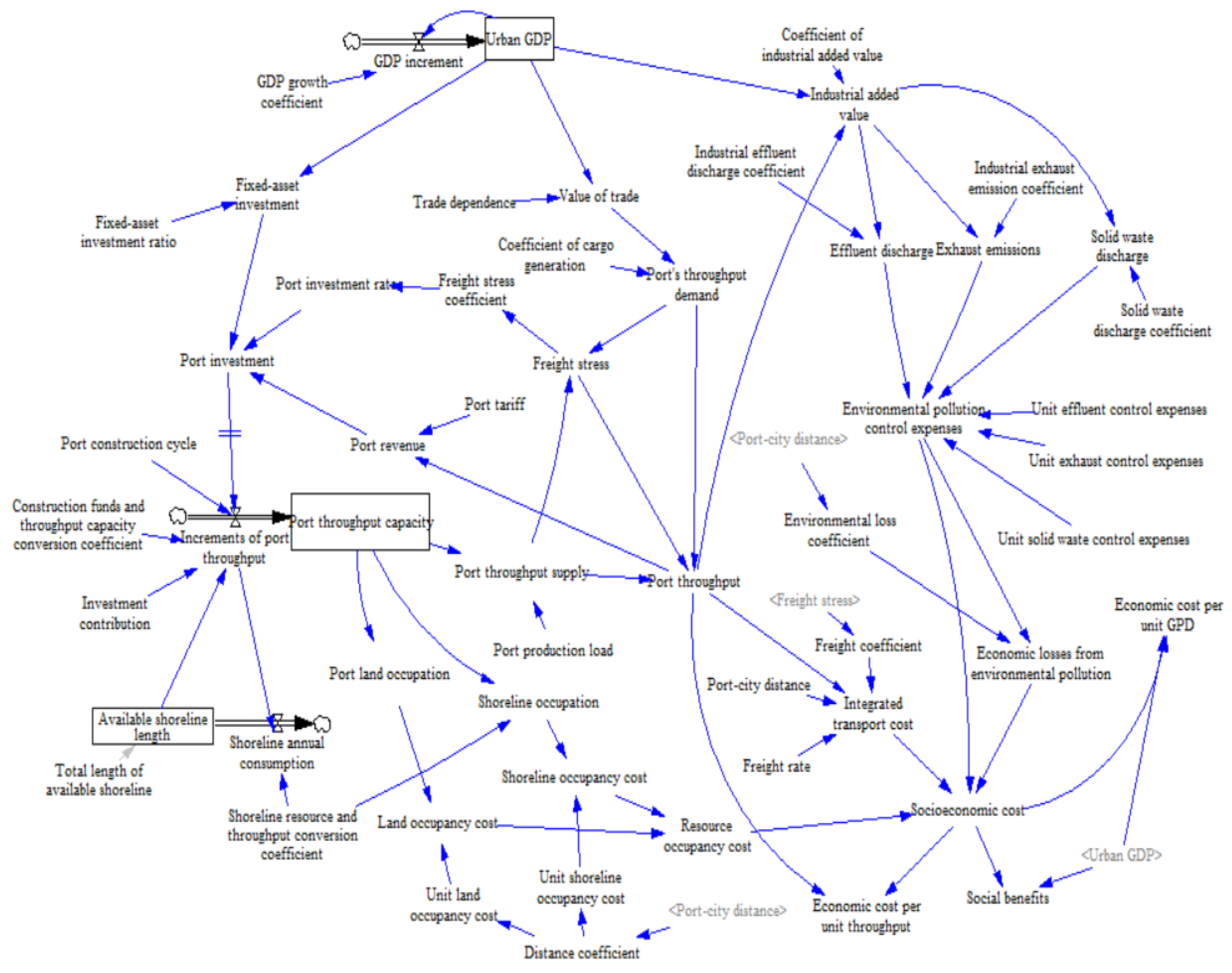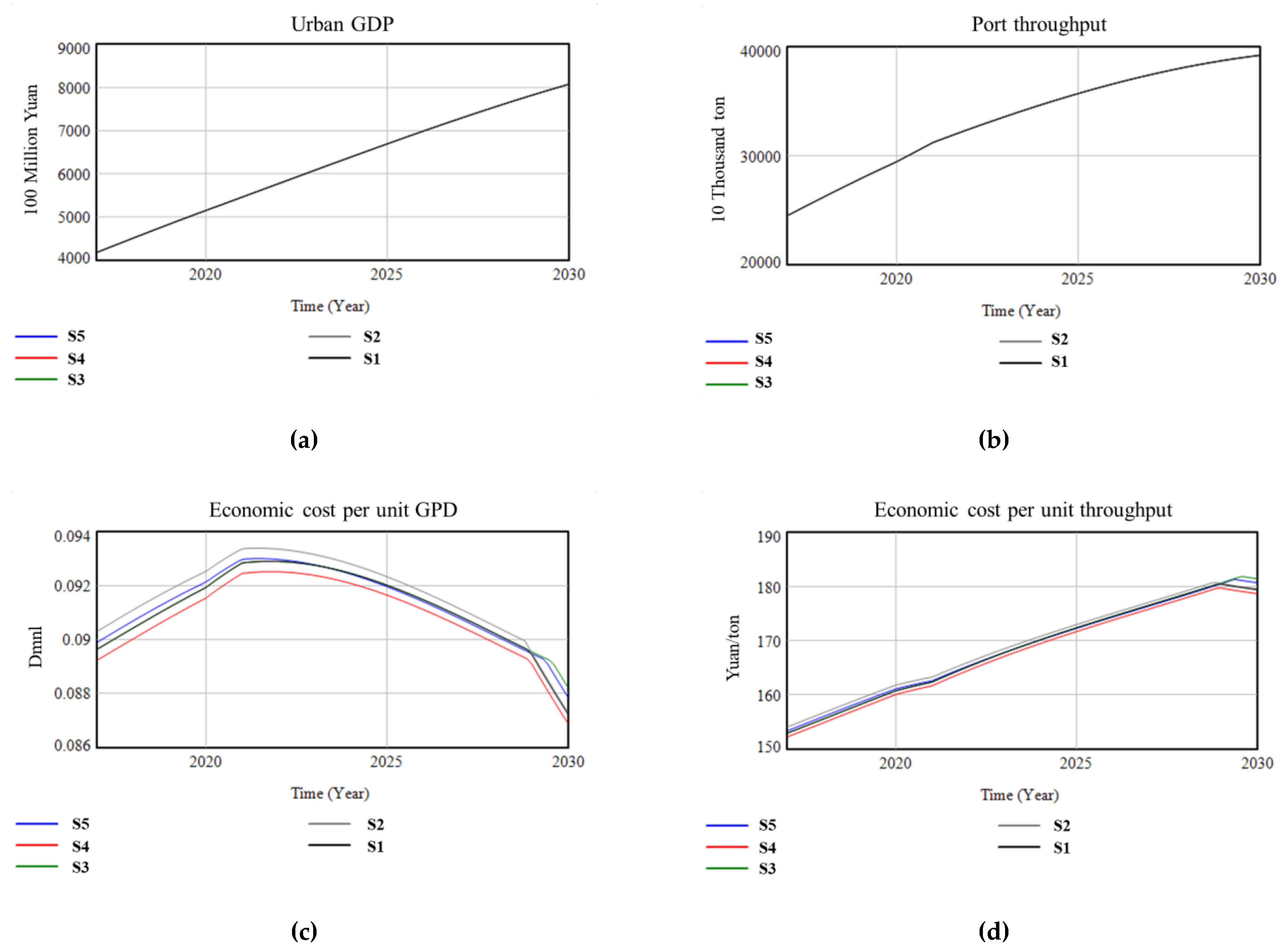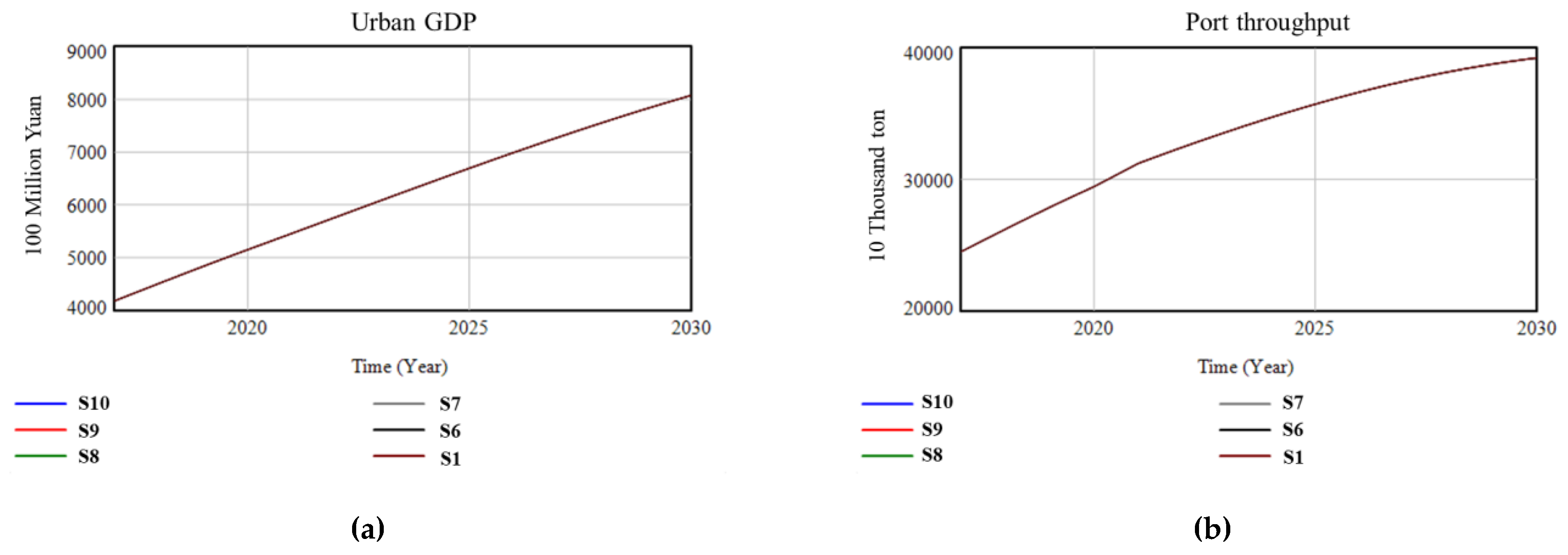Driving Mechanism of Port-City Spatial Relation Evolution from an Ecological Perspective: Case Study of Xiamen Port of China
Abstract
:1. Introduction
2. Literature Review
2.1. Existing Mechanisms of Port-cityRelations
2.2. Quantitative Research on Port-cityRelations
2.3. Under-Researched Aspects
3. Modeling
3.1. System Structure Relations
3.2. System Analysis and Indicators
3.2.1. Urban Subsystem
3.2.2. Port Subsystem
3.2.3. Environmental Resources Subsystem
3.3. Flow Chart Analysis and Equation Establishment of Port-citySpatial Relation System
4. Empirical Case
4.1. Data Sources and Model Validity Check
4.2. Simulation Test
4.2.1. Setting of Simulation Parameters
4.2.2. Scenarios and Solutions
4.2.3. Discussion of Results
5. Conclusions and Prospects
Author Contributions
Funding
Conflicts of Interest
Abbreviations
| GDP: gross domestic product | TP: freight pressure |
| GGC: GDP growth coefficient | PLO: port land occupation |
| SB: social benefits | SO: shoreline occupation |
| SEC: social economy cost | SOC: shoreline occupancy cost |
| FAI: fixed-asset investment | USOC: unit shoreline occupancy cost |
| FAIR: fixed-asset investment ratio | OLC: land occupancy cost |
| PI: port investment | ULOC: unit land occupancy cost |
| PIR: port investment rate | ROC: resource occupancy cost |
| PR: port revenue | ITC: integrated transport cost |
| CPC: cargo pressure coefficient | ATD: average transport distance |
| IPT: increments of port throughput | FR: freight rate |
| ASL: available shoreline length | IAV: industrial added value |
| CF: construction funds | CIAV: coefficient of industrial added value |
| TCCC: throughput capacity conversion coefficient | PCC: port contribution coefficient |
| IC: investment contribution | ED: effluent discharge |
| PCC: port construction cycle | CED: coefficient of effluent discharge |
| PTS: port throughput supply | EE: exhaust emission |
| PPL: port production load | CEE: coefficient of exhaust emission |
| SAC: shoreline annual consumption | SWD: solid waste discharge |
| CS: coastal resources | EPCE: environmental pollution control expenses |
| TLAS: total length of available shoreline | UECE: unit exhaust control expenses |
| VT: value of trade | USWCE: unit solid waste control expenses |
| TD: trade dependence | UECE: unit effluent control expenses |
| PTD: port throughput demand | ELEP: economic losses from environmental pollution |
| CGC: coefficient of cargo generation | ELC: environmental loss coefficient |
References
- Chen, J.; Huang, T.; Xie, X.; Lee, P.T.W.; Hua, C. Constructing Governance Framework of a Green and Smart Port. J. Mar. Sci. Eng. 2019, 7, 83. [Google Scholar] [CrossRef] [Green Version]
- Chen, J.; Xue, K.; Ye, J.; Huang, T.; Tian, Y.; Hua, C.; Zhu, Y. Simplified neutrosophic exponential similarity measures for evaluation of smart port development. Symmetry 2019, 11, 485. [Google Scholar] [CrossRef] [Green Version]
- Chen, J.; Zheng, T.; Garg, A.; Xu, L.; Li, S.; Fei, Y. Alternative maritime power application as a green port strategy: Barriers in China. J. Clean. Prod. 2019, 213, 825–837. [Google Scholar] [CrossRef]
- Debrie, J.; Raimbault, N. The port-cityrelationships in two European inland ports: A geographical perspective on urban governance. Cities 2016, 50, 180–187. [Google Scholar] [CrossRef] [Green Version]
- Hou, L.J.; Geerlings, H. Dynamics in sustainable port and hinterland operations: A conceptual framework and simulation of sustainability measures and their effectiveness, based on an application to the Port of Shanghai. J. Clean. Prod. 2016, 135, 449–456. [Google Scholar] [CrossRef]
- Hua, C.; Chen, J.; Wan, Z.; Xu, L.; Bai, Y.; Zheng, T.; Fei, Y. Evaluation and governance of green development practice of port: A sea port case of China. J. Clean. Prod. 2019, 249. [Google Scholar] [CrossRef]
- Wang, L.H.; Hong, Y. Spatial structure of container port systems across the Taiwan straits under the direct shipping policy: A complex network system approach. Acta Geogr. Sin. 2016, 71, 605–620. [Google Scholar]
- Boulos, J. Sustainable Development of Coastal Cities-Proposal of a Modelling Framework to Achieve Sustainable City-Port Connectivity. Procedia Soc. Behav. Sci. 2016, 216, 974–985. [Google Scholar] [CrossRef] [Green Version]
- Yang, W.Y.; Zhang, G.W. Transportation Geography; Commercial Press: Beijing, China, 1986; pp. 1–305. [Google Scholar]
- Wu, C.J.; Gao, X.Z. A model of port-citydevelopment. Geogr. Res. 1989, 4, 9–15. [Google Scholar]
- Notteboom, T.; Rodrigue, J. Port regionalization: Towards a new phase in port development. Marit. Policy Manag. 2005, 32, 297–313. [Google Scholar] [CrossRef]
- Liang, S.B.; Cao, Y.H.; Wu, W. Evaluation of the comprehensive effect of the interactive development between port backup area and city—The example of Shanghai WaiGaoQiao. Res. Environ. Yangtze Basin 2011, 20, 1411–1417. [Google Scholar]
- Guo, J.K.; Du, X.F.; Han, Z.L. Dynamic analysis of influencing factors on the growth of coastal ports in Liaoning province. Geogr. Geo Inf. Sci. 2015, 31, 87–100. [Google Scholar]
- Rizzo, A. Rapid urban development and national master planning in Arab Gulf countries. Qatar as a case study. Cities 2014, 39, 50–57. [Google Scholar] [CrossRef]
- Ducruet, C.; Wang, J.; Olivier, D.; Notteboom, T.; Slack, B. A metageography of port-cityrelationships Ports, Cities, and Global Supply Chains. Eng. Ashgate Publ. Ltd. 2007, 11, 157–172. [Google Scholar]
- Dutt, F.J.; Surinder, C.A. (Eds.) The Asian City: Processes of Development, Characteristics and Planning; Kluwer Academic Publishers: Dordecht, The Netherlands, 1994; pp. 52–61. [Google Scholar]
- Akhavan, M. Development dynamics of port–cities interface in the Arab Middle Eastern world: The case of Dubai global hub port–city. Cities 2017, 60, 343–352. [Google Scholar] [CrossRef]
- Ye, S.L.; Cao, Y.H.; Wang, J.W. Spatio-temporal evolution characteristics and mechanism of the port logistics system along the Yangtze River. Geogr. Res. 2018, 37, 925–936. [Google Scholar]
- Shen, Y.F.; Liu, S.H.; Zhang, J. The correspondence among industrial cluster, city group and port group on the Yangtze River area. Econ. Geogr. 2010, 30, 778–783. [Google Scholar]
- Tang, Y.T.; Chan, F.K.S.; Griffiths, J. City profile: Ningbo. Cities 2015, 42, 97–108. [Google Scholar] [CrossRef]
- Guo, J.; Wang, S.; Wang, D.; Liu, T. Spatial structural pattern and vulnerability of China–Japan–Korea shipping network. Chin. Geogr. Sci. 2017, 27, 697–708. [Google Scholar] [CrossRef]
- Monios, J.; Bergqvist, R.; Woxenius, J. Port-centric cities: The role of freight distribution in defining the port-city relationship. J. Transp. Geogr. 2018, 66, 53–64. [Google Scholar] [CrossRef]
- Schipper, C.A.; Vreugdenhil, H.; Jong, D. A sustainability assessment of ports and port-city plans: Comparing ambitions with achievements. Transp. Res. Part D 2017, 57, 84–111. [Google Scholar] [CrossRef]
- Gao, Z.Q.; Chang, D.H.; Ye, W.H. On evolvement orientations of port cities: Sustainable development strategies. China Popul. Res. Environ. 2010, 20, 102–109. [Google Scholar]
- Vallega, A. Fonctions portuaires et polarizations littorals dans lanouvelle régionalisation de la Méditerranée, quelques réflexions. French-Japanese Geogr. Colloq. 1979, 2, 44–48. [Google Scholar]
- Wang, C.; Ducruet, C. New port development and global city making: Emergence of the Shanghai–Yangshan multilayered gateway hub. J. Transp. Geogr. 2012, 25, 58–69. [Google Scholar] [CrossRef] [Green Version]
- European Port-Cityinterface and Its Asian Application. Available online: www.researchgate.net/publication/41540248 (accessed on 2 April 2020).
- Chen, H.; Luan, W.X.; Wang, Y.W. Quantitative study on relationship between port function and urban function in China. Geogr. Res. 2009, 28, 475–483. [Google Scholar]
- Jiang, L.L.; Wang, S.J.; Liu, Z.H. Evaluation and comparison of size relationship between port and port-city: Taking the port-cities of Liaoning Province as example. Sci. Geogr. Sin. 2011, 31, 1468–1473. [Google Scholar]
- Wu, Q. The revolution of port-cityrelationship in modern China (1961–1936): The analysis to the relation concentration index as the example. J. Chin. Hist. Geogr. 2012, 27, 70–81. [Google Scholar]
- Liang, S.B.; Cao, Y.H.; Wu, W. The effect analysis of Nanjing city–port interactive development under the background of globalization. Geogr. Res. 2007, 3, 599–608. [Google Scholar]
- Yang, S.; Pan, J. Dynamic simulation and regulation of port-citycoupling development: Taking Lianyungang as a case. Geogr. Res. 2011, 30, 1021–1031. [Google Scholar]
- Guo, J.K.; Han, Z.L. The port-cityspatial system evolution theory and empirical study of Chinese seaport city. Sci. Geogr. Sin. 2013, 33, 1285–1292. [Google Scholar]
- Berjghe, K.V.D.; Jacobs, W.; Boelens, L. The relational geometry of the port-city interface: Case studies of Amsterdam, the Netherlands, and Ghent, Belgium. J. Transp. Geogr. 2018, 70, 55–63. [Google Scholar] [CrossRef]
- Zhao, Q.Y.; Xu, H.; Wall, R.S.; Stavropoulos, S. Building a bridge between port and city: Improving the urban competitiveness of port cities. J. Transp. Geogr. 2017, 59, 120–133. [Google Scholar] [CrossRef]














| IGDP = GDP × GGC |
| SB = GDP − SEC |
| FAI = GDP × FAIR |
| PI = FAI × PIR + PR × coefficient |
| PIR = CPC × coefficient |
| IPT = IF THEN ELSE (ASL > 2000, DELAY3 (CF and TCCC × PI × IC, PCC), DELAY3 (CF and TCCC × PI × IC, PCC) × 0.01) |
| PT = INTEG (IPT) |
| PTS = PT × PPL |
| SAC = IPT × CS and TCC |
| ASL = TLAS + INTEG (−SAC) |
| VT = GDP × TD |
| PTD = VT × CCG |
| ROC = LOC + SOC |
| ITC = PT × ATD × FR × (1 + coefficient × FP^4) |
| FP = PTD / PTS |
| SEC = ELEP + ITC + ROC + EPCE |
| IAV = GDP × CIAV + PT × PCC |
| ED = CED × IAV |
| EE = CEE × IAV |
| SWD = CSWD × IAV |
| EPCE = SWD × USWCE + UECE × EE + UECE × ED |
| PT = IF THEN ELSE (FP > 1, PTS, PTD) |
| PLO = PT × coefficient |
| SO = PT × coefficient |
| SOC = SO × USOC |
| LOC = PLO × ULOC |
| Year | GDP (Billion Yuan) | Total Import and Export Values (Million USD) | Throughput (10,000 Tons) | Trafficability (10,000 Tons) | Length of Occupied Shoreline (m) | Industrial Added Value above a Designated Scale (100 Million Yuan) | Port Investment (100 Million Yuan) |
|---|---|---|---|---|---|---|---|
| 2007 | 1388 | 39,778 | 8117 | 8266 | 17,763 | 625 | 31 |
| 2008 | 1560 | 45,389 | 9702 | 9261 | 16,773 | 680 | 26 |
| 2009 | 1737 | 43,314 | 11,096 | 9559 | 17,598 | 670 | 30 |
| 2010 | 2060 | 57,036 | 12,728 | 10,041 | 18,522 | 869 | 27 |
| 2011 | 2539 | 70,167 | 15,654 | 13,439 | 22,597 | 1117 | 35 |
| 2012 | 2817 | 74,491 | 17,227 | 14,104 | 23,923 | 1164 | 26 |
| 2013 | 3018 | 84,094 | 19,088 | 14,174 | 24,431 | 1212 | 18 |
| 2014 | 3274 | 83,553 | 20,504 | 16,188 | 27,934 | 1240 | 19 |
| 2015 | 3466 | 83,291 | 21,023 | 16,550 | 28,827 | 1254 | 21 |
| 2016 | 3784 | 77,177 | 20,904 | 17,300 | 29,749 | 1265 | 23 |
| Year | Actual GDP (100 Million Yuan) | Simulated GDP (100 million Yuan) | Deviation (%) | Actual Throughput (10,000 Tons) | Simulated Throughput (10,000 Tons) | Deviation (%) |
|---|---|---|---|---|---|---|
| 2007 | 1388 | 1388 | 0.00% | 8117 | 8338 | 2.72% |
| 2008 | 1560 | 1563 | 0.17% | 9702 | 9388 | −3.24% |
| 2009 | 1737 | 1785 | 2.74% | 11,096 | 10,722 | −3.38% |
| 2010 | 2060 | 2101 | 1.97% | 12,728 | 12,975 | 1.94% |
| 2011 | 2539 | 2570 | 1.20% | 15,654 | 15,690 | 0.23% |
| 2012 | 2817 | 2816 | −0.05% | 17,227 | 16,523 | −4.09% |
| 2013 | 3018 | 3042 | 0.79% | 19,088 | 18,587 | −2.63% |
| 2014 | 3274 | 3270 | −0.10% | 20,504 | 19,658 | −4.13% |
| 2015 | 3466 | 3522 | 1.61% | 21,023 | 20,164 | −4.08% |
| 2016 | 3784 | 3848 | 1.69% | 20,904 | 20,217 | −3.29% |
| Scenario | Contribution of Investment | Conversion Factor of Shoreline Resources and Throughput (m/10,000 Tons) | Unit Cost for Pollutant Treatment (10,000 Yuan/10,000 Tons) | Port-cityDistance (km) |
|---|---|---|---|---|
| 1 | 0.62 | 1.95 | 0.5 | 5 |
| 2 | 0.64 | 1.95 | 0.5 | 5 |
| 3 | 0.62 | 1.90 | 0.5 | 5 |
| 4 | 0.62 | 1.95 | 0.48 | 5 |
| 5 | 0.64 | 1.90 | 0.48 | 5 |
| 6 | 0.62 | 1.95 | 0.5 | 20 |
| 7 | 0.64 | 1.95 | 0.5 | 20 |
| 8 | 0.62 | 1.90 | 0.5 | 20 |
| 9 | 0.62 | 1.95 | 0.48 | 20 |
| 10 | 0.64 | 1.90 | 0.48 | 20 |
| 11 | 0.62 | 1.95 | 0.5 | 100 |
| 12 | 0.64 | 1.95 | 0.5 | 100 |
| 13 | 0.62 | 1.90 | 0.5 | 100 |
| 14 | 0.62 | 1.95 | 0.48 | 100 |
| 15 | 0.64 | 1.90 | 0.48 | 100 |
© 2020 by the authors. Licensee MDPI, Basel, Switzerland. This article is an open access article distributed under the terms and conditions of the Creative Commons Attribution (CC BY) license (http://creativecommons.org/licenses/by/4.0/).
Share and Cite
Yu, L.; Xu, P.; Shi, J.; Chen, J.; Zhen, H. Driving Mechanism of Port-City Spatial Relation Evolution from an Ecological Perspective: Case Study of Xiamen Port of China. Sustainability 2020, 12, 2857. https://doi.org/10.3390/su12072857
Yu L, Xu P, Shi J, Chen J, Zhen H. Driving Mechanism of Port-City Spatial Relation Evolution from an Ecological Perspective: Case Study of Xiamen Port of China. Sustainability. 2020; 12(7):2857. https://doi.org/10.3390/su12072857
Chicago/Turabian StyleYu, Ling, Pengfei Xu, Jia Shi, Jihong Chen, and Hong Zhen. 2020. "Driving Mechanism of Port-City Spatial Relation Evolution from an Ecological Perspective: Case Study of Xiamen Port of China" Sustainability 12, no. 7: 2857. https://doi.org/10.3390/su12072857
APA StyleYu, L., Xu, P., Shi, J., Chen, J., & Zhen, H. (2020). Driving Mechanism of Port-City Spatial Relation Evolution from an Ecological Perspective: Case Study of Xiamen Port of China. Sustainability, 12(7), 2857. https://doi.org/10.3390/su12072857




